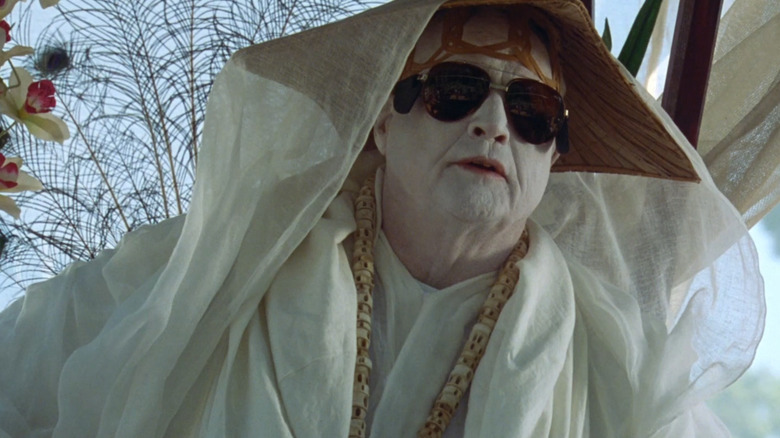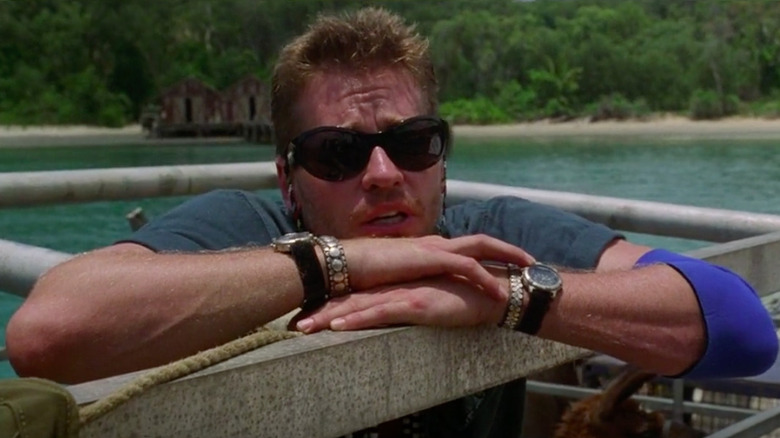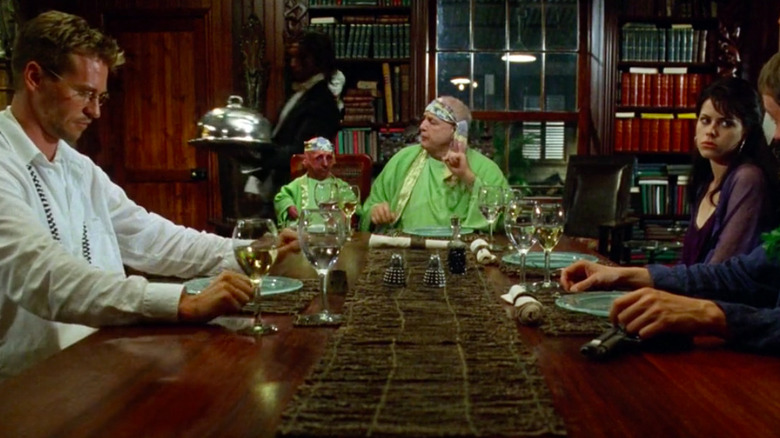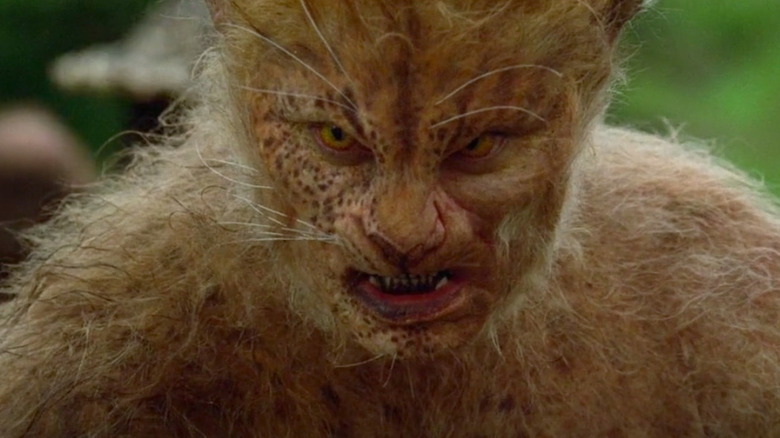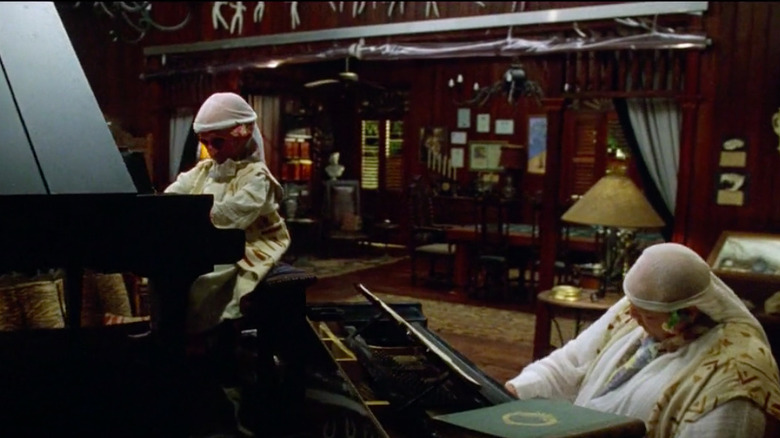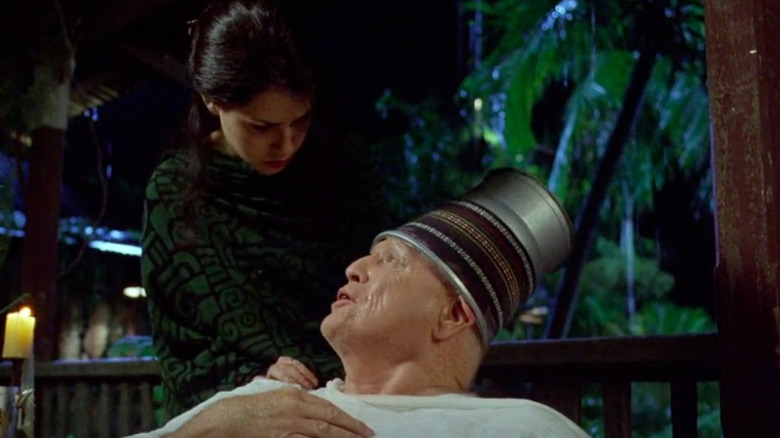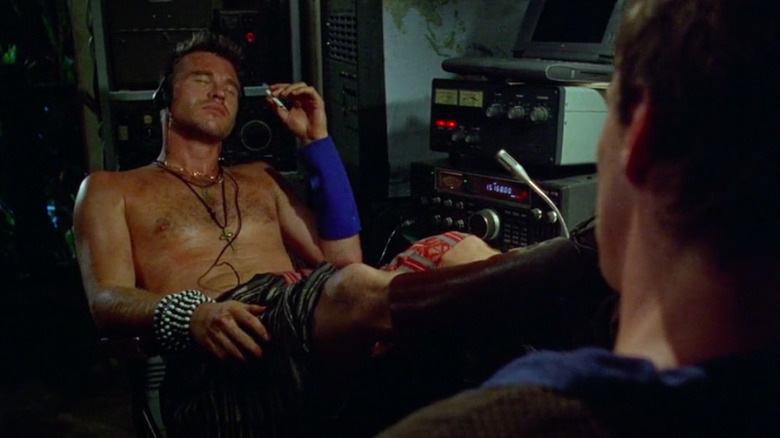Marlon Brando's Demands On Island Of Dr Moreau Sent Production Spiraling Out Of Control
We may receive a commission on purchases made from links.
Despite its reputation as one of the most notorious flops of the '90s, "The Island of Dr. Moreau" almost passes as a watchable movie. It's nicely shot, the makeup effects are terrific, and on a surface level, it appears to be a standard Hollywood sci-fi horror. But then, right from the opening scene, something seems very off.
The first clue is the voice over from David Thewlis, parachuted in at the last moment to play the lead. With his flat Lancashire accent jibing badly against the glossy photography, it feels like a skit parodying Hollywood voice overs. That's just for fun, because as the film unfolds, that bad feeling radiates off the screen. Everyone in the principal cast, with the possible exception of Marlon Brando, looks like they're hating every second of it, and the tension is palpable.
It's difficult to enjoy "Moreau" in a "so-bad-it's-good" sense, because while it is competently made at times, the atmosphere is rank. It made me feel like when I accidentally walked in on my parents fighting as a kid. No wonder it stank out theaters and made its original director, Richard Stanley, vanish for 25 years.
The troubled shoot, so wonderfully detailed in the documentary "Lost Soul: The Doomed Journey of Richard Stanley's The Island of Dr. Moreau," is legendary — an ill-starred collision of three eccentric talents at very different stages in their careers. The first was Stanley, a young director of "esoteric witchiness" (according to the doc) who was nevertheless regarded as the next big thing after his first two low-budget cult items, "Hardware" and "Dust Devil." Then came Val Kilmer at the peak of his career after "Batman Forever," and screen legend Marlon Brando, reputed for his often difficult and disruptive behavior on set. It was a potent mix that turned out to be a recipe for disaster.
So what happens in The Island of Dr. Moreau again?
After his plane crashes in the Java Sea, U.N. negotiator Edward Douglas (Thewlis) is rescued by a passing ship, where he receives medical attention from Dr. Montgomery (Kilmer). Montgomery is heading home to the mysterious Moreau island, where he persuades Douglas to also disembark.
Put up as a guest in the main house in Moreau's compound, Douglas is warned not to go wandering about and locked in his room at night. This only spurs Douglas to break out and have a nose around. He enters a lab and is horrified to see a strange creature giving birth to a child, delivered by bestial human hybrids. Hey, at least they look like they scrubbed up.
The creatures spot him and he does a runner, crashing through the jungle and bumping into Aissa, Dr. Moreau's daughter (Fairuza Balk). She takes him to a Mutant Village, where the Sayer of the Law (Ron Perlman) preaches human-like qualities such as restraint and discipline. Moreau rolls up and uses a remote control to pacify the hybrids with radio controlled implants under their skin. Douglas is still frightened but Moreau manages to calm him down with a mad scientist exposition speech.
A partially eaten rabbit is discovered, outraging the other creatures as eating another's flesh is forbidden. The blame falls on Lo-Mai, a leopard hybrid, who is shot dead at the following day's trial in retribution. His corpse is cremated and his implant is revealed to the other creatures, who are in no mood to take Moreau's orders any longer.
Richard Stanley was fascinated with the source novel from H.G. Wells since his childhood, and he began writing his own screen version after the success of "Dust Devil." After four years in development, he got the green light on his dream project. Despite Stanley's evident talent, it was a massive step up from low-budget indie features to a big Hollywood production with major stars. If only he could get the right people onboard...
Marlon Brando and a warlock's intervention
Although Stanley wrote the part of Dr. Moreau with Jurgen Prochnow in mind, one of the first people approached for the role was Marlon Brando. The actor quickly accepted, still fascinated by the character of Colonel Kurtz he played in "Apocalypse Now" and intrigued by the parallels between Kurtz and Dr. Moreau.
Back in the 19th century, H.G. Wells was incensed when his friend Joseph Conrad published "Heart of Darkness," feeling that he ripped off his enigmatic main character. Conrad defended his book, claiming that Kurtz was based on British explorer Henry Morton Stanley, who was Richard Stanley's great grandfather.
New Line offered the film to Roman Polanski instead. Stanley was furious, demanding to speak with Brando and delving into the dark arts (according to "Lost Soul"):
"Knowing that the odds were stacked against me, I resorted to witchcraft. At that point in time, I was friendly with this warlock chappie in England, Dr. Edward James Featherstone, commonly known as Skip. So Skip had been shown to demonstrate his ability to fix things, to do invisible mending before, so I said, "My God, Skip, you've got to help me! You've got to save my movie!" At the exact time I went into the meeting [with Brando] on the other side of the world, Skip convened his coven, cut his arm, and drew a sigil..."
Whether Skip's magic worked or it was simply that Brando, himself an unusual character, unexpectedly connected with Stanley over the subject at hand, we will never know. But suddenly Polanski was out again and Stanley back in, with Brando refusing to make the movie without him.
It must have seemed like a blessing at the time for the younger director, although he undoubtedly knew that working with Brando presented its own unique challenges. As it turned out, Stanley never even got to direct him in a scene.
The cast comes together, but disaster strikes
With Brando good to go, it was time to find a big box office star for the lead role of Edward Douglas. Bruce Willis initially signed on, with James Woods coming in for the Montgomery part. Then came the first in a long series of misfortunes: Willis entered divorce proceedings with Demi Moore and couldn't leave the country, so he was out.
Val Kilmer took his place, but when Stanley flew to Tokyo to finalize the details, the actor decided he was too busy in the wake of "Batman Forever" to play the part and demanded 40% less shooting time on the film. Fearful that the studio might pull the plug if he also lost Kilmer, Stanley devised a work around. Kilmer would take the smaller role of Montgomery instead, meaning Woods was also out. Rob Morrow, then hot from a role on "Quiz Show," replaced Kilmer in the Douglas part.
In pre-production, a remote location in Queensland, Australia was chosen to represent Moreau's island and Stan Winston's effects team busied themselves live-casting extras for the animal hybrids, including Nelson de la Rosa, one of the smallest men on earth and a huge star in his native Dominican Republic.
Then it all started falling apart. Brando's daughter, Cheyenne, took her own life shortly before filming began, and it wasn't clear when the actor would arrive for the shoot, if at all. Stanley's PA was bitten by a poisonous spider and Skip the Warlock, whose day job was a bio-chemist, was accidentally irradiated by one of his experiments, causing his bones to crumble. According to Stanley, all the things Skip fixed with his magic came undone during his time in hospital, including Stanley's movie.
Stanley's mother's house in Ireland was struck by lightning and, when he started shooting around Brando's absence, a fierce hurricane blew in and washed away some of the sets. With the production put on hold and Thewlis replacing Morrow at the last second, Stanley was fired after just three days. All of this is covered in the "Lost Soul" documentary.
Brando finally arrives
Richard Stanley's dismissal caused bad feeling on set, especially with Fairuza Balk, who was so upset that she threatened to quit and got someone to drive her to Sydney, around 2,400km from the movie's "base camp" in Cairns. Nobody looks like they are enjoying themselves in "Moreau," and she looks visibly unhappy in her scenes.
John Frankenheimer, an old-school director who was the polar opposite of Stanley, was brought in to salvage the picture. He had a reputation for managing big egos, but his brash ways immediately upset many of the cast and crew. Some suspected that making a monster movie wasn't really Frankenheimer's thing but, like everyone else, "Lost City" confirms that he wanted to work with Brando.
Brando was still a no-show, and nobody really knew where he was. Finally, a week after he was due on set, the enigmatic actor arrived and made an immediate impression. In his first scene, he imperiously arrives on the back of a truck, wrapped in white cloth and plastered in crudely applied makeup, wearing huge shades. Brando decided to do his own makeup, including dentures to give himself an overbite, and adopted a vague British accent for the role.
Brando's performance is so bizarre that it's very easy to make fun of it, but we should also give the guy a little benefit of the doubt since it was so soon after his daughter's tragic death. But if the production of "The Island of Dr. Moreau" was troubled before he arrived, things were about to get a whole lot weirder now he was on set.
Brando starts making crazy demands
Marlon Brando had a history of disruptive behavior, wild ideas, and outlandish demands throughout his career. He didn't bother reading the script, and instead he relied on his assistant to relay his lines to him via radio, reportedly causing confusion when he picked up the police wavelength and started repeating emergency calls (via Far Out). Brando and Kilmer took a disliking to each other and embarked on a battle of egos, each refusing to leave their trailer until the other did.
Already under time pressure and worried about further delays, the crew put up with Brando's demands just to get something on film. So when he wanted peacock feathers for his grand entrance, an assistant hurried out and plucked a few right off a live peacock's butt (via "Lost Soul"). When he decided he wanted an ice bucket hat to keep him cool, he got that too.
Brando also wanted to change the script, inventing his own plot points and deciding that he didn't want his character to die (via FX Guide). Later, he suggested to Frankenheimer that they shut down production for a few months so they could re-write the script, working in a twist revealing that Dr. Moreau was a dolphin all along.
Most disruptively, Brando became instantly smitten with de la Rosa, the diminutive extra originally cast in a minor background role. Brando wanted him as his sidekick in all his scenes, despite la Rosa's lack of English or acting experience. On top of that, he wanted his new pal dressed the same, which later provided inspiration for Mini-Me in the "Austin Powers" trilogy (via Entertainment Weekly).
Some suspected that Brando was acting strange just to mess with the director and his bosses, while Kilmer looks like he's on a sour-faced mission to try out-weirding the maestro. In a few scenes, Kilmer almost succeeds, although his quirks seem to come from a place of genuine spite. Meanwhile, Brando's ad-hoc contributions least brighten the film up, making it a singular mess — a work of inadvertent camp directed through gritted teeth by the veteran helmer Frankenheimer.
Aftermath, and a glimpse of what might have been
Richard Stanley, with his interest in witchcraft, could surely be forgiven for thinking that malign forces were swirling around his doomed film, and his part of the "Moreau" story didn't end after he was fired. The studio paid his full fee to keep him quiet and instructed crew members to take him to the airport, but he never got on his flight out of Australia. Instead, he camped out in the forest near the production and got crew members to sneak him back on set disguised as a human-dog hybrid. He is visible in the background of some scenes (via "Lost Soul"). Stanley said:
"I had the privileged position of being able to see what was going on, but at the same time the rather nightmarish position of discovering that I was now one of the beast people... that I had completed a full arc from creative figure to a dog."
After the disaster of "Moreau," Brando continued his slide into irrelevance and still never made another good film before he passed away in 2004. Kilmer certainly kept himself busy, but he never again reached his previous level of fame, making mostly bad movies for the next 25 years with a few notable exceptions. Meanwhile, Stanley, who walked away from filmmaking after his dream project was taken away from him, made an unlikely comeback with "Color Out of Space," where he showed exactly what he could do adapting a classic piece of sci-fi horror literature with an eccentric actor (Nicolas Cage) in the lead role.
H.P. Lovecraft, Richard Stanley, and Nicolas Cage were an inspired mix, with the latter giving one of his best performances of recent years. The film gave us a tantalizing indication of what Stanley might have achieved with H.G. Wells and Marlon Brando — if the studio just had the courage to stick with him.
